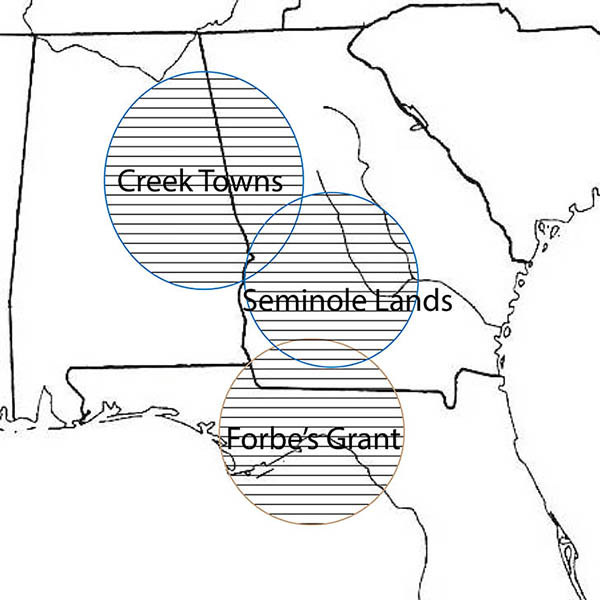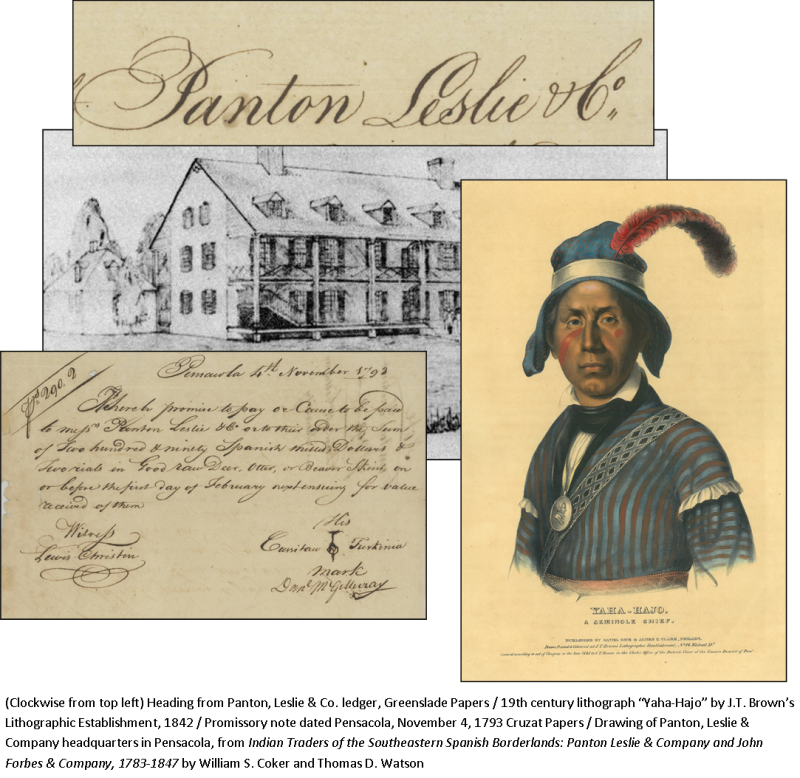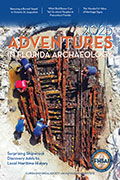In 1763, Spain ceded the Florida territory to Britain in exchange for the Havana, a result of allegiances during the French and Indian War. Known as the British Period (1763-1783) it marked the beginning of England’s colonization attempts on the peninsula. The dividing line between East and West Florida became the Apalachicola River, with the British colony of Georgia to the north, and the Mississippi River to the west. The territory was sparsely populated with most of the European colonists living in and around St. Augustine in East Florida, and Pensacola in West Florida, the capitals of each colony respectively. The groups now moving into Florida when the British took over colonial control were an amalgamation of many smaller Native American clans and familiar groups who were loosely linked by language and custom in the southeastern U.S. The British began in earnest meeting with the local leaders within these Indigenous communities and established ties that led to trade agreements. Key to the economic success of the British Floridas was a successful, trusting, and fruitful relationship with the various Indigenous groups living in and bordering the Floridas. The primary commodities coming out of the wooded backcountry were deer and otter pelts, more so the former. Items being imported and traded for the aforementioned peltry were Europeans metal goods such as firearms, gunpowder, jewelry, clothing and alcohol. Although the economy of the colonies was important, the other, and arguably the more pressing reason that the British catered to the needs and wants of the Indian population was strategic military alliances. During the French and Indian war, the British relied upon the provision of Indigenous American warriors to fight alongside the white colonists and the British army to defend her colonial possessions.
The North American continent presented a wealth of resources beyond just precious metals such as the ones mined from Central and South America. More importantly, the continent possessed natural resources and ample land for agriculture which by the 18th century would prove to be a driving force in the rapid immigration of Europeans into the Americas. Control of raw materials produced in the Americas became the motivating force between European traders and Indigenous inhabitants during the late 18th and early 19th centuries. This competitive environment proved perfect for the emergence of large-scale trading operations which could handle the volume of necessary arms and goods coming into North America, but also the volume of deerskins and other peltry being exported out. It was through political coercion, complex trading networks, and opportunistic dealings that the partners and traders involved were able to procure so much wealth in the span of only a few decades. The enormous financial successes of the company and its successor, John Forbes and Company (JF&CO), are not the key issues explored in this project. Rather, it was the effect on Creek and Seminole Indian culture and trade that paved the way for hostilities between Anglo settlers and Indians in Florida during the Creek Civil War and the Seminole Wars period. The exertion of soft power upon the Indigenous populations led to the breakup of the clan systems and eventually led to the aforementioned armed conflicts. It is through the exploration of original documents, combined with the presentation of these materials in the form of podcasts that the long-term impacts of the late colonial period Indian trade can be better understood.
In this exhibit you can search through original documents relating to the fur trade and listen to audio podcatsts which provide context for these narratives
You can also connect and share your thoughts about this exhibit through the Florida Historical Societies Facebook page. We invite discussions on this topic and will expand and improve upon the exhibit based on user feedback.
The Trade on the ground • Talks with Native Americans • Land Cessions • Time and Place
Teacher's Guide
Public Files:
| Attachment | Size |
|---|---|
| 177.92 KB |
Exhibit Section:
The Trade On The Ground
Audio File:
Exhibit Item:
1796 McGillivray Letter
Exhibit Segment:
1798 McQueen Letter
Exhibit Segment:
Land Cessions
Audio File:
Exhibit Item:
Letter 1802
Exhibit Segment:
Letter December 24th 1803
Exhibit Segment:
Letter May 31st 1801
Exhibit Segment:
Time and Place
Maps have the ability to transport us to a distant time and place. The original maps featured in this portion of the exhibit build on the original documents you've already seen.
Below you can CLICK on the highlighted area to see an original period map depicting various aspects of the fur trade in Florida and the southeast, and the locations of historic trading towns, Spanish cities, established trading routes, as well as other information pertianing to the trade as it existed at the end of the 18th century
Lastly, you can see a survey of one of the largest land cessions granted to the trading firm John Forbes & Co., at the begning of the 19th century. The nearly 1.2 million acre tract was exchanged for absolution of debt owed to the company by various Seminole and Creek Indian clans.

Creek Towns are in the 1763 T. Jeffreys map
Seminole Towns are in the 1783 Purcell map
Forbe's Grant is depicted in the 1805 Forbes Purchase map
Exhibit Item:
1763 T. Jeffreys
Exhibit Segment:
1783 Purcell
Exhibit Segment:
1805 Forbes Land Cessions
Exhibit Segment:
Talks with Native Americans
As a network of trade and traders developed and expanded across the southeastern United States around the turn of the 18th century, the need for regular meetings between the various Native American clans and the merchants providing their goods. Each preceeding document chronicles a different transcription of these meetings at various times throughout the trading relationship. Referred to as "talks" by the Native Americans, each letter covers a variety of issues, including often a list of goods needed for further trade, and even messages for other chiefs. Broader political issues stemming from American traders moving into Creek towns and inter-clan dissagrements are also discussed.
What these "talks" tell us about the trade relationship is just how intertwined politics, trade and issues of sovreignty were during this brief period (1790 - 1812). They also show the ebb and flow of agency between involved parties. Over the years, depending on economic conditions, power was exchanged between merchant and consumer.
Be sure to CLICK on images for larger view and the audio podcasts at the beginning of the documents to hear a discussion about talks with Native Americans.








